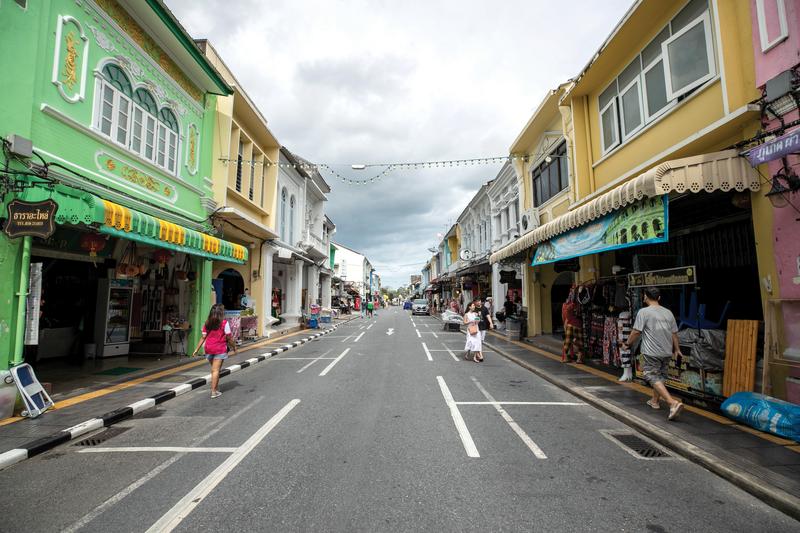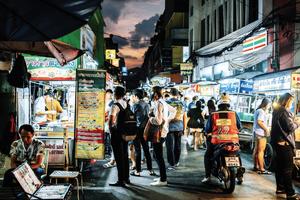 A street in Phuket, Thailand, is largely deserted during the pandemic. (ZHANG KEREN / XINHUA)
A street in Phuket, Thailand, is largely deserted during the pandemic. (ZHANG KEREN / XINHUA)
Early in the morning on Nov 10, Luke Wu rushed to a 7-Eleven convenience store immediately after being released from 14 days’ quarantine at a hotel in Bangkok, the Thai capital.
After having his temperature checked at the store entrance, the freelance photographer from Beijing grabbed a cup of Thai milk tea.
Later that day, he ate hotpot at a shopping mall with a friend to celebrate being able to resume his first overseas trip since the COVID-19 pandemic started.
Wu, who lives on commissions from media companies and used to travel overseas at least once a month, said, “I take pictures of wild animals, different cultures and natural landscapes, but I had to put my work on hold for six months.”
He decided to resume work overseas after Thailand announced a special tourist visa for Chinese visitors.
On Oct 26, Wu arrived in Bangkok on a chartered flight from Guangzhou, capital of Guangdong province, and started his quarantine at the hotel.
He received commissions from magazines and drew up his schedule. He began his work, which will take several months to complete, in Bangkok.
Wu will then move on to villages close to the city and to beaches. He plans to return to China sometime next year.
He was among the second batch of visitors from China to travel to Thailand on the special visas, following a group which arrived on Oct 20. Members of this group were the first overseas arrivals granted permission to land in Thailand for seven months.
The special tourist visa program was devised by Thai authorities with the aim of gradually reopening the country’s borders to foreign visitors.
Many observers view this as a good start to help the Thai economy recover from the pandemic step by step. The Southeast Asian nation welcomed nearly 40 million foreign visitors last year and, according to some estimates, tourism accounts for more than 10 percent of its GDP.
Meanwhile, on Nov 6, Singapore lifted border restrictions for visitors from the Chinese mainland. Travelers must have a COVID-19 test upon arrival, but do not need to be quarantined if they produce a negative result.
 A public health worker at Bangkok’s Suvarnabhumi airport checks tourists arriving from Shanghai on special visas on Oct 20. (WASON WANICHAKORN / AP)
A public health worker at Bangkok’s Suvarnabhumi airport checks tourists arriving from Shanghai on special visas on Oct 20. (WASON WANICHAKORN / AP)
Xu Liping, director of Southeast Asian studies at the Chinese Academy of Social Sciences, noted that “many countries in the region, especially those that rely greatly on such business, have reached out to China and neighboring nations to salvage tourism industries that have been hit hard by COVID-19.”
Having a low and controlled number of coronavirus infections has to be a prerequisite for easing restrictions in Southeast Asia, Xu said.
With nearly 9 percent of the global population, the region has only recorded some 2 percent of COVID-19 cases worldwide and 1 percent of fatalities.
This accomplishment is due largely to timely and strict measures implemented by many countries, Xu said.
He added that a strategy of reopening gradually to foreign visitors is a sound start for countries in Southeast Asia, with China standing out as a source market target due to the successful way in which it has controlled the virus.
Last year, Thailand was one of the top overseas destinations for Chinese tourists, who by far accounted for the country’s largest number of visitors by nationality. Some 11 million Chinese visitors boosted the Thai economy to the tune of US$17 billion.
However, the tourism industry across the globe has been devastated by the pandemic, which has shattered economies, infected more than 62 million people and left close to 1.5 million dead.
International tourist arrivals dropped by 65 percent year-on-year during the first six months of this year, according to a report by the World Tourism Barometer, a UN agency.
Among the regions, Asia-Pacific, the first to feel the impact of the pandemic on tourism, was the hardest hit, with a 72 percent fall in tourists for the six-month period.
Wu, the photographer, has witnessed evidence of declining tourist numbers in Bangkok. Many popular destinations that used to be buzzing with foreign visitors are now far less crowded, he said.
“Numerous restaurants that were popular among foreign tourists had to close due to the pandemic,” he added.
Wu pointed out that the Thai government had implemented a series of preventive measures, including the compulsory wearing of face masks in public areas.
“In Thailand, people are very careful and have maintained good personal hygiene, such as wearing masks and observing social distancing. Hand sanitizers are also available in public places. I think life has almost returned to normal, as the infections now being reported are mostly imported cases,” he said.
 A passenger is tested for COVID-19 on arrival in Bangkok. (LUKE WU / FOR CHINA DAILY)
A passenger is tested for COVID-19 on arrival in Bangkok. (LUKE WU / FOR CHINA DAILY)
Wu added that despite the gloomy outlook for businesses driven by tourism, many popular local restaurants are welcoming more customers. With Christmas approaching, diners are lining up in front of these eateries.
“The government here is more focused on boosting domestic consumption and has introduced stimulus measures, including subsidies and tax incentives, for small businesses,” he said.
While some 40 million overseas tourists arrived in Thailand last year, the country will struggle to attract 25 percent of that number this year, according to the Tourism Authority of Thailand. The pandemic is also expected to result in an 80 percent fall in tourism revenue for the country this year.
In Indonesia, the number of foreign visitors plunged by more than 70 percent year-on-year from January to September.
In the first half of this year, Cambodia also experienced a huge slump in overseas tourist arrivals. The country welcomed 1.18 million visitors during this period, a fall of 64 percent from the same time last year, according to Xinhua News Agency.
To rescue their pandemic-battered tourism industries and economies, Asia-Pacific countries have sought regional cooperation as, compared with other parts of the world such as Europe and the United States, the number of new COVID-19 infections remains low.
On Nov 12, leaders of the Association of Southeast Asian Nations member states adopted the ASEAN Declaration on an ASEAN Travel Corridor Arrangement Framework in a joint effort to restore tourism and facilitate regional cooperation during the pandemic. The declaration was adopted on the first day of the 37th ASEAN Summit.
Song Qingrun, an associate professor at Beijing Foreign Studies University, said the declaration demonstrates a shared vision among ASEAN countries to strengthen regional cooperation in the tourism industry, which attracts millions of visitors to the region each year.
“Tourism is a very important and large-scale industry in Southeast Asia. It’s pivotal for local economies, not just because millions of people visit the region, attracted by its spectacular coastlines, but also due to the numerous benefits it brings to restaurants, hotels, airline companies and even taxi drivers,” Song said.
If the tourism industry can recover, even gradually, it will help trigger a regional economic revival.
During the ASEAN summit, broader cooperation was highlighted as 15 countries signed the Regional Comprehensive Economic Partnership, or RCEP, which covers about 30 percent of the global population.
The partnership consolidates free trade agreements between the 10 ASEAN member states and China, Australia, Japan, New Zealand and South Korea.
“The RCEP is expected to bring East Asian countries to the debating table for new joint measures to better flatten the COVID-19 curve, which will also pave the way for non-essential travel in the region,” Song said.
So-called travel corridors had emerged long before the November declaration.
 Local visitors are returning to night markets in the Thai capital. (LUKE WU / FOR CHINA DAILY)
Local visitors are returning to night markets in the Thai capital. (LUKE WU / FOR CHINA DAILY)
The concept of “travel bubbles “was first proposed by Australia and New Zealand, before being quickly examined by other nations as a possible way to get international travelers on the move again. Countries that sign the RCEP agreement allow for non-essential journeys without quarantine.
But these bubbles — also known as travel corridors or travel bridges — have yet to materialize for a number of reasons.
The latest attempt at a bubble fell short when the authorities in Singapore and Hong Kong delayed their plan after COVID-19 infections rose in Hong Kong. The bubble had been due to take effect on Nov 22.
On Nov 28, Edward Yau Tang Wah, Hong Kong’s minister of commerce and economic development, said the city would resume the tourism bubble plan with Singapore once the new cases are contained.
The government hopes to set up a system allowing residents to travel overseas safely and will continue to work with trade partners on this, Yau added.
When Thailand announced the special tourist visas, the news went viral on Chinese social media platforms, with many people saying they wanted to take winter breaks in Southeast Asia.
However, these potential travelers have been confronted by some hard truths.
The cost of 14-days’ quarantine is high — both financially and in terms of time.
Wang Min, a 32-year-old Beijing office worker who loves to travel, was thrilled when she saw news of the visa. She tried to book a trip to Thailand to make up for her Spring Festival holiday, which was ruined by the pandemic.
“In January, I planned to spend Spring Festival in Thailand, but didn’t make it because of the outbreak. When I saw news of the visas online, I couldn’t help dream about strolling the streets and eating the tasty food there,” she said.
However, after Wang consulted online travel agencies, she was given the blunt facts.
A package trip, including an application for the special visa, quarantine fee and chartered flight costs 35,000 yuan (US$5,332), according to a staff member from China Youth Travel Service.
Several other travel agencies, including Golden Goose, which is based in Thailand, quoted similar prices.
Wu, the photographer, said he paid nearly 40,000 yuan for his one-way trip to Thailand.
He does not recommend that tourists visit Thailand at present, as the Chinese government has requested that outbound travel be avoided.
Wu said cost is not the only factor. If Chinese travelers want to visit Thailand, they have to spend a total of 28 days in quarantine in the two countries.
“I have come here (Thailand) largely to make a living and experience the local life. The special visa can be renewed twice and allows me to stay in the country for 270 days. However, it is impossible for most Chinese office workers to take 28 days off to be quarantined.”
Health security is another major concern, with the pandemic rampant in other parts of the world. Even in Southeast Asia, attempts to control the spread of COVID-19 have been uneven.
The Philippines and Indonesia are still working hard to contain the disease, while infection curves in countries such as Singapore, Thailand, Malaysia and Brunei indicate they have it under control.
Song, the associate professor, said, “The prerequisite for normalized cross-border travel is to ensure people’s health and safety during the pandemic. It’s far too early to announce a full recovery and say that the region and the world have emerged from the shadow of the pandemic.”
Wu said that even though Thailand has done a good job in containing COVID-19, there is still a risk.
“There is no need to take such a risk if it is not necessary,” he said, adding that nearly all the passengers taking the chartered flight he was on were heading to Thailand for essential business.
Getting hold of an air ticket is also not easy. Only a limited number of chartered flights between China and Thailand are currently available and tickets must be sold by authorized travel agencies.
The staff member from China Youth Travel Service said, “We only have one more chartered flight available from China to Thailand this year, but the number will gradually rise as the situation improves.”
Experts voiced optimism, saying that after vaccines become available, the tourism industry will start to recover.
According to a survey by global management consultants McKinsey & Company, Chinese travelers are increasingly warming to the idea of foreign travel, with nearly one-third of respondents from eight Chinese cities saying they are ready to make such trips for their next vacation.
Song said: “Out of the depth of misfortune comes bliss. It’s been hard in recent months, but hopefully pent-up demand will help the tourism sector catch up fast.”



